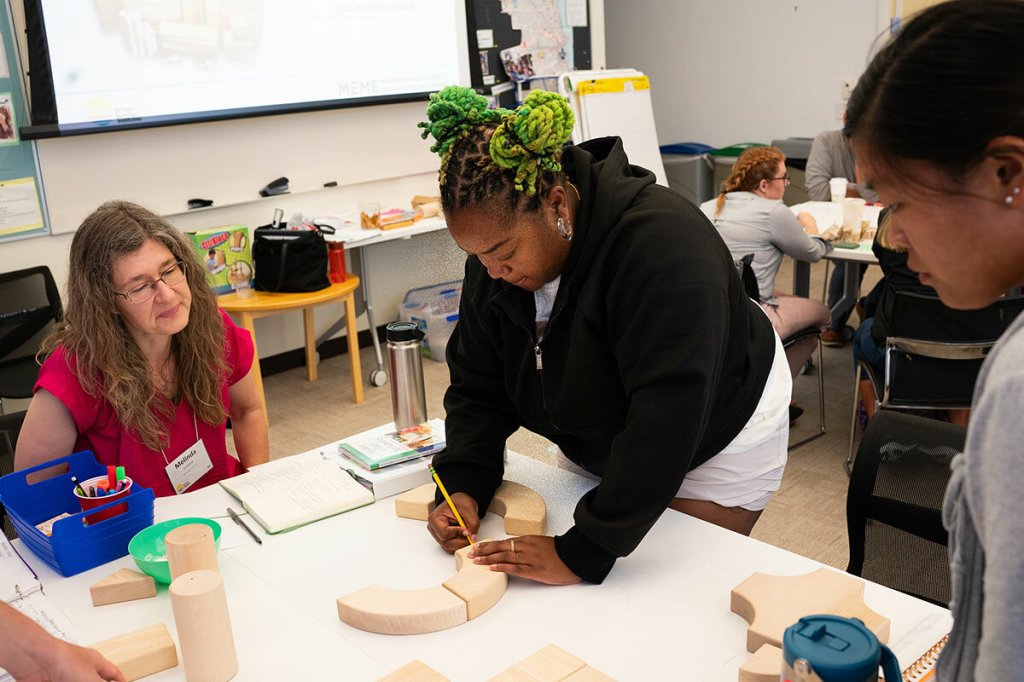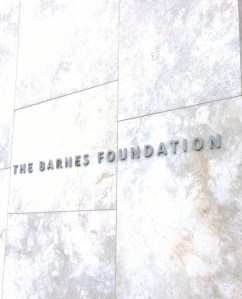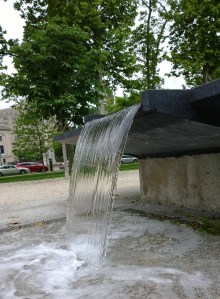
Photo: Camilla Forte/The Hechinger Report via CSM.
Ivory McCormick (center) attends a math conference July 12, 2023, in Chicago. The Atlanta teacher says her school’s math specialist helped change the way she feels about teaching the subject.
I can identify with the teachers in this story who have a math phobia. I had to teach all subjects to 10-year-olds for a couple years and was relieved that my school offered a math consultant. I had never trusted my math — although that had a lot to do with parental perceptions.
Ariel Gilreath, of the Hechinger Report, researched an interesting program designed to help teachers of young students gain confidence in the critical foundations of math. The story is shared at the Christian Science Monitor.
“In July, in a packed classroom in downtown Chicago, a group composed mostly of early elementary teachers and child care workers read a story about ‘Wendi,’ a fictional preschool teacher who loves reading but struggles in math.
“Even though Wendi was drawn to early education where ‘math was so easy,’ she still felt unsure of her skills. In the story, she decided to skip math concepts, leaving them for the teachers her students would have next year.
“Across the room, people nodded their heads as they listened.
“ ‘I am Wendi. Wendi is me,’ said Ivory McCormick, a kindergarten teacher from Atlanta. Several educators in the classroom identified with Wendi, and that was the point. Decades of research shows that math anxiety is a common problem for adults, and surveys show it particularly affects women, who make up nearly 90% of elementary teachers in the United States.
“Put simply, a lot of elementary school educators hate the prospect of teaching math, even when the math concepts are beginner level.
“Researchers at the Erikson Institute, a child development-focused graduate school in Chicago, started the Early Math Collaborative 16 years ago to provide educators with research-backed professional development to help them better teach young students math. One of the goals of Erikson’s annual four-day summer math conference, where the teachers read Wendi’s story, is to assuage their anxiety by exploring how young children learn math and strategizing activities they can do in the classroom.
“Because math competencies build on each other, with skills like counting and learning shapes forming the basis of later knowledge, it’s critical that students receive a solid foundation in the subject, education experts say. The U.S. has long trailed many other developed countries in terms of student math performance, and then scores tanked during the pandemic. …
“ ‘If you look at how a child is doing with math when they enter kindergarten, that’s the best way to predict how they’re going to be doing with math later, all the way up through eighth grade,’ says Jennifer McCray, an associate research professor at Erikson. …
“When Ms. McCormick started teaching preschool five years ago, she felt anxious about teaching a subject she didn’t feel confident in. ‘Math was something I always had to work really hard at, and it seemed like I never really got that much better at it,’ she says.
“Teachers who doubt their math ability often worry they will transfer their math aversion onto impressionable students, educators say. There are studies that validate this fear: First grade students who were taught by teachers with heightened anxiety about math performed worse in the subject than their peers who were taught by less anxious teachers, one study from 2020 found.
“Math specialists say it is a pervasive issue in elementary classrooms, where educators are typically expected to teach every subject, and it often leads to teachers spending less classroom time on math content. …
“At the Erikson Institute’s summer conference, teachers gained practice on concepts they’d use in their classrooms. They drew maps to describe directions: Rosie the hen traveled over the fence, and under the tree branch, and through the river, for example. They built large 10-sided shapes out of colorful blocks. The exercises benefited their own math skills, too.
“ ‘There’s a misbelief that in order to teach early childhood math, you don’t really need to know math well,’ Lauren Solarski, a consultant and coach with the Early Math Collaborative at Erikson, told the group of educators. ‘But having that deep content knowledge, research finds, makes you then able to draw out what’s happening in a child’s play around math – what they’re doing – and know those trajectories, know the math inside and out so that you can be that expert when you’re with the child.’
“That doesn’t necessarily mean early childhood teachers need to be experts in advanced geometry or algebra, says Lisa Ginet, director of program design and operations at Erikson. But it does mean they need to know how different lessons that may not seem to be related to math are connected to mathematical thinking and to topics students will learn as they get older. …
“For Ms. McCormick, the early ed teacher from Atlanta, attending Erikson’s professional development conference was the next step in her journey to building up her math confidence. This year, Ms. McCormick moved up to teaching first grade at the Galloway School in Atlanta after teaching preschool and kindergarten classes at the school for several years. She credits her school’s decision to hire a math specialist last year with helping change the way she feels about teaching the subject. …
“ ‘This past year, I have kind of revamped my thoughts about what math can be and the ways that we teach it in order to make kids want to learn about it and be enthusiastic about it. Because the way we present it to them holds so much more weight than I think I ever realized.’ ”
More at the Monitor, here. No paywall, but your subscription will support good journalism.










